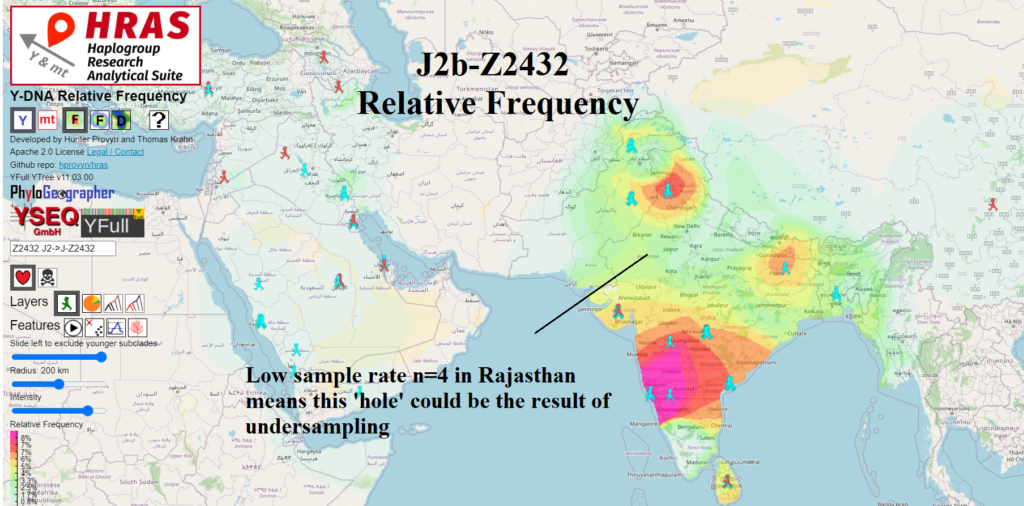Himachal Pradesh is one of the northernmost provinces of India. "Hima" comes from Sanskrit and means 'snow'. However I believe that the ancestors of the J2b-Z2432 men now living there and elsewhere in South Asia may have been living there long before the introduction of Indo-Aryan Vedic languages, given the high diversity there and very little presence elsewhere of branches of this lineage that are over 7500 years old.

The above relative frequency map of J2b-Z2432 was computed by HRAS based on YFull v11.03 (near the release of that version) and does not yet include the sample from Himachal Pradesh in the calculation. Since there will only be one sample from Himachal Pradesh, the effective frequency of J2b-Z2432 would be 1/1 = 100% for this region. However since HRAS distributes the weight of samples in a circle, with radius commensurate to the designated geocode's area, the frequency computed by it will be somewhat below 100%, i.e. some of J2b-Z2432 higher signal from that sample 'bleeds' into adjacent areas and lower J2b-Z2432 signal from adjacent areas 'bleeds' into Himachal Pradesh. It may sound a bit morbid to a foreign tongue to use the word bleed, please excuse my English.
Time will tell what the true relative frequency of this line in Himachal Pradesh is. For now we can assume that it outnumbers R1a, though not with a high degree of confidence given the sample size was 1. If R1a outnumbered J2b-Z2432 then we would have expected the first sample on the YFull YTree to represent R1a.
The hitherto relative maximum in Goa (two J2b-Z2432 samples out of a total of four from IN-GA, Goa), approaching about 40% due to bleed of adjacent areas, I think will not be surpassed in any of the previously well-sampled regions like Pakistani Punjab (n=65) and Indian Punjab (n=18). Both men from Goa have a relatively recent TMRCA for this line, of only 3100 years so we can treat this maximum as a founder effect.
Slightly deeper shared roots of migrants to South Asia pushed from J2b-Z2449 with 7500 ybp TMRCA back to J2b-Z2433 with 7700 ybp TMRCA
One result of this new sample is that the oldest branch of J2b-Z2432 with Neolithic time-frame diversity in South Asia moves from 7500 year TMRCA J2b-Z2449 to slightly older J2b-Z2433 with 7700 ybp TMRCA.
This does not necessarily mean that the J2b-Z2433 MRCA had already migrated to South Asia by 5700 BCE. This ancestor may have still been living somewhere in or near Iran by that time. In that case, only J2b-Z2449 along with J-Y258293, the child line of the sibling containing the Himachal Pradesh sample, may have migrated 'together' east later, leaving one cousin behind that now 'remains' in the furthest east province of Iraq, Maysan.
This migration to South Asia likely took place not much later than 5500 BCE given that these lines are nearly exclusively found there, despite the opportunities of further migration in the ensuing millennia that could have obscured this origin.
Could SRS8752765 from Turkey represent a Bronze Age Mitanni-mediated migration to Anatolia?
This new sample from Himachal Pradesh's closest male line relative comes from Turkey. The new sample resulted in the reduction of the number of SNPs defining their branch J-Y258293 from 54 to 41. The TMRCA has not yet been recalculated but the old figure was 3200 ybp. For a Mitanni-mediated migration we would expect a TMRCA older than 1600 BCE when they were already mentioned in Babylonian texts. Even if the TMRCA will not be recalculated to be any older, I think we are still close enough to consider this possibility, given the error interval.
One interesting thing about this question is that if it were true, then SRS8752765 would descend from an indigenous South Asian male line that became integrated with an Indo-Aryan speaking group (themselves migrants from the direction of Central Asia) which in turn contributed to the ethnogenesis of the Mitanni.
I think we should definitely consider this for a possible explanation. I think that, lacking ancient samples to prove this, more modern samples from West Asia, especially in the proximity to the Mitanni Empire would need to be found to be more closely related to SRS8752765 for this theory to be more reliable. Then we would have circumstantial evidence to show that the migration from South Asia was Late Bronze Age and not later.
Also we would want to find additional presence in South Asia under their line J-FT282078 to be certain that this sample from Himachal Pradesh's geography is truly indicative of his deeper origin, as we are simply assuming for now given the deep diversity in South Asia of his closest Neolithic cousins J2b-Z2449.